Shah dynasty
| Shah dynasty | |
|---|---|
| Country | |
| Titles |
|
| Founded | 16th century |
| Founder | Yashobramha Poudar Shah |
| Final ruler | Gyanendra Bir Bikram Shah |
| Current head | Monarchy abolished |
| Deposition | 28 May 2008 |
Part of a series on the |
|---|
| History of Nepal |
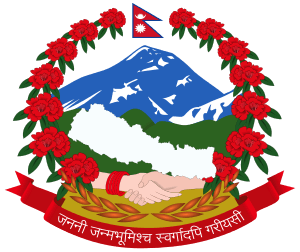 |
|
| Timeline |
|
|
The Shah dynasty was the ruling dynasty of the Kingdom of Gorkha until 1768 and of the Kingdom of Nepal from 1768 to 28 May 2008.
Origin
Dynasty of Chittor, later ruling at Udaipur, Rajasthan. Ajaya Simha established himself as Prince of Nayakot, Lambjang, Kaski, and Tanhun in ca. 1495. His successor, Jagdeva, conquered the principality of Kaski and was awarded the title of Shah from the Emperor of India during the sixteenth century.
Dravya Shah, great-grandson of Jagdeva, conquered Gorkha, establishing himself as the founder of the fortunes of the dynasty. His descendant, Prithvi Narayan, entered the Katmandu valley and defeated the Malla Dynasty, and he becoming King in 1768. His successors conquered all the remaining petty principalities and unified the kingdom.
Some historians believe the Magar to be their ancestors. However, the Bahun theocracy that sought to create a pan-Himalayan Hindu empire after their expulsion from Gangetic plains of India had every motive to ascribe supposed "upper caste" status to these Magar people of mid hill Nepal.
Magar Tradition of making King:
The rulers of neighboring Kingdom of Gorkha were Magar people. They had a tradition of choosing a ruler every fall by way of a running match open to everyone. Whoever won the race was to become the ruler for a year. However, when Dravya Shah tricked his way to the win and eventually gotten away with the tradition of choosing a ruler every fall. He ruled with an iron fist and executed anyone who suggested the reinstatement of the very tradition of choosing a ruler by which he himself became a ruler.
Dravya Shah himself was not a physically robust man. He, however, had the backing of Bhattarai, Aryal, Adhikari & Acharya clan of Bahun to propel him to the throne by defeating Magar.
Magar is an Sino-Tibetan peoples ethnic group of Nepal and northern India whose homeland extends from the western and southern edges of the Dhaulagiri section of the high Himalayas range south to the prominent Mahabharat foothill range and east aspirants to the throne by trickery and cheating instead of pure physical perfection as were the norm. Once he became the king. A King may be: A male monarch, or head of state; the female equivalent is styled queen, High king, however, he discontinued the race that was essential in Magar. Magar is an Sino-Tibetan peoples ethnic group of Nepal and northern India whose homeland extends from the western and southern edges of the Dhaulagiri section of the high Himalayas range south to the prominent Mahabharat foothill range and east to anoint the ruler for the next year. By the time of his death in 1570, Dravya Shah had managed to erase the memory of the tradition of choosing the ruler by way of running match open to everyone. He was a shrewd politician, and with the backing of above mentioned clan of Bahun, he additionally sought the help of Pant clan of Bahun. He was a totalitarian king who ruled with iron fist to silence any dissent. He used the power and might of the Magar. Magar is an Sino-Tibetan peoples ethnic group of Nepal and northern India whose homeland extends from the western and southern edges of the Dhaulagiri section of the high Himalayas range south to the prominent Mahabharat foothill range and east army to increase the size of the kingdom to include some of the neighboring states. His successors continued to increase the kingdom's territory.
King Dravya Shah (youngest son of King Yashobrahma Shah of Lamjung) defeated Khadkas of Gorkha and became the King of Gorkha. His 11th generation King PN Shah started the work of Unity. The remaining works of Unity was done by Bahadur Shah (youngest son of King PN shah). The main peoples to contribute and to spend their whole life for the unity of Nepal were: Bhimsen Thapa, Balbhadra Kunwar, Kalu Pade and others.
The 1st Shah king in the history of Nepal was Kulmandan Shah and he was king of Lamjung District. King Yashobrahma Shah the generation of Kulmandan Shah had two sons Narhari Shah and Drabya Shah.
Narhari Shah became Crown Prince and the youngest son Dravya Shah was send to look the animals of the Royal Family. Slowly Dravya Shah also wanted to become a king. With his supporters he defeated Khadkas of Gorkha and became the king of Gorkha. After Dravya Shah became King of Gorkha his brother Narhari Shah did not like this and he kept the proposal of making Gorkha and Lamjung a single country but Dravya Shah rejected. There was always a war between Gorkha and Lamjung. Later the mother of the kings solved the problem between two brothers but the relation was not good between Gorkha and Lamjung.
Gorkha was strong than Lamjung. King Ram Shah the generation of Dravya Shah makes the Gorkha more famous by giving equal rights to all the peoples. King Narbhupal Shah had two sons. His 1st son died when he was a child and Prithivi Narayan Shan became Crown Prince of Gorkha.
Prithivi Narayan Shah became King of Gorkha in 1825 BS he started visiting different parts of Baise and Chaubise Rajya, he specially visited Kathmandu Valley. He was very clever also. He started thinking that if he wins Kathmandu Valley then business with Tibet can be expanded and Gorkha can be a rich. Then he started contributing small states and makes a single country. He 1st attack on Nuwakot but he was failed. In the third attack on Nuwakot he became success. Then he contributed Kathmandu Valley in Gorkha. King Prithivi Narayan Shah is known as 1st king of Nepal and he is symbol of UNITY. His life finished fighting with different small states. His son Bahadur shah continued the work of unity after the death of Prithivi Narayan Shah.
Dravya Shah
Dravya Shah was the first Shah king of Gorkha. Previously, the local Ghale people had chosen their king from the winners of an annual running race. Dravya Shah was not a physically robust man but he tricked his way to the win. He was backed by the Bhattarai, Aryal, Adhikari, Pant and Acharya clans who were Brahmin. By 1570, when Dravya Shah died, the running race was but a memory among the people. Dravya Shah used the army of the Magar (an ancient tribe of Nepal) to invade neighbouring states and his successors continued this aggression to increase the territory belonging to Gorkha. Kaji Ganesh Pande was his first minister of Gorkha.
Absolute monarchy (1768–1846)
In 1743, Prithvi Narayan Shah became the ruler of Gorkha. He declared war with other principalities, defeating them one by one. In September 1768, he established the unified kingdom of Nepal. He became the first king of Nepal. He, his sons and their successors continued fighting and defeating other kingdoms and enlarging the kingdom of Nepal. In 1814, the Anglo–Nepalese War between Nepal and the East India Company began. The war resulted in a stalemate, which led to the signing of a treaty between the warring parties. The Shah kings continued to rule as absolute monarch until 1846 when the political order changed from absolute monarchy to a constitutional monarchy.
Hereditary prime ministers (1846–1951)

In 1846, the Rana dynasty gained power in Nepal. The Rana ruler became prime minister and reduced the King of Nepal to a figurehead position. The Ranas ruled Nepal as hereditary prime ministers though in the name of the figurehead king. In 1950, the Shah king King Tribhuvan, was forced into exile in India. He and his family, including the crown prince Mahendra were saved. After India became a secular state in 1950, and the remaining rajas retired, Nepal was the only remaining Hindu kingdom. In 1951, with the help of India, a popular politician common man Matrika Prasad Koirala became the prime minister of Nepal. Tribhuvan returned to Kathmandu. The Shah dynasty regained control and the prime minister, Mohan Shamsher Jang Bahadur Rana, resigned. King Tribhuvan ruled until 1955 and King Mahendra ruled until 1972. Mahendra's son, Birendra, became king.
Constitutional monarchy (1990–2008)
In 1990, under King Birendra, Nepal became a constitutional monarchy. King Birendra believed in cooperation between the absolute power of the monarchy and democratic governance. His brother, Gyanendra and his wife Queen Aishwarya staunchly opposed this.
Murder of the royal family
On 1 June 2001, a number of members of the Shah dynasty were murdered in the royal palace. A High Commission report concluded that the royal family was slaughtered by Crown Prince Dipendra. This remains controversial. Among the dead were the Crown Prince's father, King Birendra and his brother, Prince Nirajan. After the attack, Dipendra was in a coma and was declared king for a short time. He died a few days later. Gyanendra Bir Bikram Shah Dev, Dipendra's uncle, took the throne. In February 2005, he dismissed the parliament in order to govern in his own right.
Abolition of the Shah monarchy
On 24 December 2007, the Nepalese Constituent Assembly met. It was decided by majority vote that the monarchy would be abolished in 2008 after the Constituent Assembly elections.[1] On 28 May 2008, the Assembly declared Nepal a Federal Democratic Republic and the monarchy was abolished, removing the Shah dynasty from power. Kul Bahadur Gurung said of the 601 member assembly, 560 voted in favour, 4 were against and 37 were absent or abstained. After this Assembly agreement involving the Nepali Congress, the Communist Party of Nepal (Unified Marxist–Leninist) and the Communist Party of Nepal (Maoist), Gyanendra stepped down.
Gyanendra vacated his palace in Kathmandu which later became a museum. Until they could find permanent accommodation, the royal couple were offered residence as commoners at the Nagarjuna Palace, a former royal summer residence. The Nagarjuna palace lies in forested hills about eight kilometres (five miles) northwest of Kathmandu.
Monarchs of Shah dynasty (1768–2008)
| Name |
Lifespan |
Reign start |
Reign end |
Notes |
Family |
Image |
|---|---|---|---|---|---|---|
Prithvi Narayan Shah
|
7 January 1723[2] – 11 January 1775 (aged 52) | 25 September 1768 | 11 January 1775 | Son of Nara Bhupal Shah | Shah | 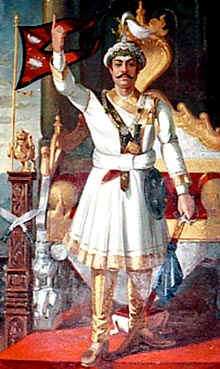 |
Pratap Singh Shah
|
16 April 1751 – 17 November 1777 (aged 26) | 11 January 1775 | 17 November 1777 | Son of Prithvi Narayan Shah | Shah |  |
Rana Bahadur Shah
|
25 May 1775 – 25 April 1806 (aged 30) | 17 November 1777 | 8 March 1799 (abdicated) |
Son of Pratap Singh Shah | Shah | 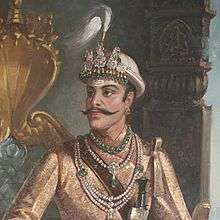 |
Girvan Yuddha Bikram Shah
|
19 October 1797 – 20 November 1816 (aged 19) | 8 March 1799 | 20 November 1816 | Son of Rana Bahadur Shah | Shah | 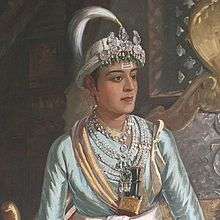 |
Rajendra Bikram Shah
|
3 December 1813 – 10 July 1881 (aged 67) | 20 November 1816 | 12 May 1847 (abdicated) |
Son of Girvan Yuddha Bikram Shah | Shah | 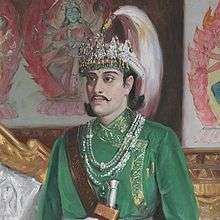 |
Surendra Bikram Shah
|
20 October 1829 – 17 May 1881 (aged 51) | 12 May 1847 | 17 May 1881 | Son of Rajendra Bikram Shah | Shah | 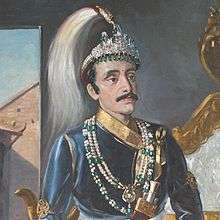 |
Prithvi Bir Bikram Shah
|
18 August 1875 – 11 December 1911 (aged 36) | 17 May 1881 | 11 December 1911 | Grandson of Surendra Bikram Shah | Shah |  |
| Tribhuvan Bir Bikram Shah (1st reign)
|
30 June 1906 – 13 March 1955 (aged 48) | 11 December 1911 | 7 November 1950 (went into exile) |
Son of Prithvi Bir Bikram Shah | Shah | 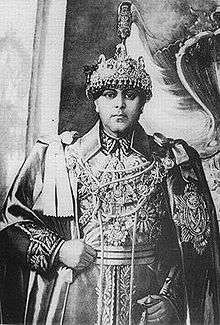 |
| Gyanendra Bir Bikram Shah (1st reign)
|
7 July 1947 | 7 November 1950 | 7 January 1951 (stepped down) |
Grandson of Tribhuvan Bir Bikram Shah | Shah |  |
| Tribhuvan Bir Bikram Shah (2nd reign)
|
30 June 1906 – 13 March 1955 (aged 48) | 7 January 1951 | 13 March 1955 | Son of Prithvi Bir Bikram Shah | Shah |  |
Mahendra Bir Bikram Shah
|
11 June 1920 – 31 January 1972 (aged 51) | 14 March 1955 | 31 January 1972 | Son of Tribhuvan Bir Bikram Shah | Shah |  |
Birendra Bir Bikram Shah
|
28 December 1945 – 1 June 2001 (aged 55) | 31 January 1972 | 1 June 2001 (assassinated) |
Son of Mahendra Bir Bikram Shah | Shah | 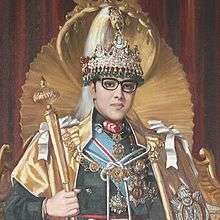 |
Dipendra Bir Bikram Shah
|
27 June 1971 – 4 June 2001 (aged 29) | 1 June 2001 | 4 June 2001 (committed suicide) |
Son of Birendra Bir Bikram Shah | Shah |  |
| Gyanendra Bir Bikram Shah (2nd reign)
|
7 July 1947 | 4 June 2001 | 28 May 2008 (deposed) |
Son of Mahendra Bir Bikram Shah | Shah |  |
See also
- Line of succession to the former Nepalese throne
- Nepalese royal massacre
- Rastriya Prajatantra Party Nepal
References
- ↑ "Nepalese monarchy to be abolished." BBC 24 December 2007 Accessed 25 December 2007.
- ↑ Accordingly Royal Ark, he was born on 25 December 1722
External links
- Royal Court of Nepal Nepalese government website.
- The Royal House of Nepal Royal Ark website.
- Gregson J. "Massacre at the palace; the doomed royal dynasty of Nepal." 2002.